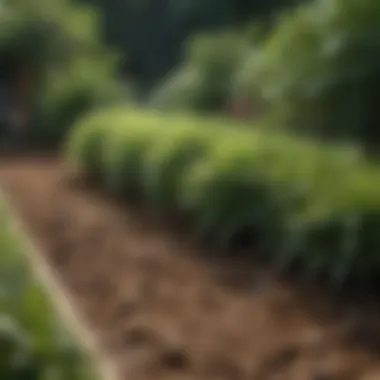Natural Methods for Effective Weed Control


Intro
Weeds are the uninvited guests of any garden. They not only compete with desired plants for nutrients but can also disrupt the aesthetic value one seeks in a well-maintained garden. The quest for effective weed control often leads gardeners to rely on chemical herbicides. However, an increased awareness of environmental issues has shifted preferences toward natural methods. This article will delve into various organic techniques to eliminate weeds efficiently while promoting sustainable gardening practices.
In this exploration, we will discuss a range of practical solutions to this common gardening challenge. The focus will be on homemade remedies, the implementation of natural ground covers, and alternative tools that support an eco-friendly approach to weed management. We will also highlight the importance of fostering healthy plant growth as an integral part of any weed control strategy.
As we progress through this guide, readers will gain insight into how to keep their gardens thriving without harming the environment. Caring for one’s garden can simultaneously be a rewarding and challenging endeavor. The journey of weed control is just one aspect that contributes to the health and beauty of outdoor spaces.
Understanding Weeds
What are Weeds?
Weeds are generally defined as plants that grow in places where they are not wanted. They compete with cultivated plants for nutrients, light, and water, often leading to reduced growth and yield. The term "weed" is subjective, meaning a plant considered a weed in one context may be valued in another. For instance, clover is often seen as a nuisance in lawns but is beneficial in gardens for its ability to fix nitrogen in the soil. Therefore, understanding the specific context and environment is key to identifying weeds correctly.
These plants often have traits that allow them to thrive; they may grow quickly, have deep roots, or produce a large number of seeds. Common traits include:
- Fast growth rates
- High seed production
- Adaptability to various conditions
By recognizing these characteristics, gardeners can plan their strategies accordingly.
The Role of Weeds in Ecosystems
Weeds fulfill various ecological roles, many of which are beneficial despite their reputation as nuisances. They help prevent soil erosion by stabilizing the ground with their roots. This stabilization is crucial for areas that are prone to flooding or soil movement. Additionally, some weeds can improve soil fertility by attracting beneficial insects or fixing nitrogen.
Moreover, weeds can provide habitats for wildlife, insects, and microorganisms. Particularly, pollinators may rely on flowering weeds for sustenance. It is also observed that some weeds can suppress certain pest populations, essentially acting as natural deterrents.
In summary, weeds are an important part of ecosystems. Realizing their benefits can change the perspective on how to manage them in gardens and agricultural environments.
Common Types of Weeds
Several weed species are commonly encountered in gardens. A gardener's ability to identify these is crucial for effective weed management. Here are a few notable types:
- Dandelion (Taraxacum officinale): Known for its bright yellow flowers, commonly found in lawns.
- Crabgrass (Digitaria spp.): A grass-type weed that can quickly overtake lawns and garden beds.
- Thistle (Cirsium spp.): Characterized by spiny leaves and purple flowers, thistles can dominate a space if not managed early.
- Purslane (Portulaca oleracea): This succulent is often considered a weed but is edible and nutritious; it grows rapidly in warm conditions.
Understanding the characteristics and habits of these common weeds can help gardeners mitigate their presence effectively in a sustainable manner.
Natural Weed Killers
Natural weed killers play a crucial role in effective garden maintenance. Unlike traditional chemical methods, they focus on using organic solutions that minimize environmental impact. By opting for natural alternatives, gardeners not only reduce harm to beneficial insects but also create a healthier ecosystem. The importance of natural weed killers cannot be overstated, especially for those committed to sustainable gardening practices.
In this section, we will explore various natural weed killers. Each method has its own unique attributes, benefits, and considerations that can aid gardeners in their quest to manage weeds efficiently.
Vinegar Solutions
Types of Vinegar
Vinegar is a popular natural weed killer due to its acetic acid content. The commonly used types of vinegar include white vinegar, apple cider vinegar, and specialty horticultural vinegar. White vinegar typically contains a 5% acidity level, while horticultural vinegar can reach up to 20%. This high concentration makes it particularly effective against a wide range of weeds.
The key characteristic of vinegar as a weed killer is its ability to desiccate plant tissues upon direct contact. This unique feature makes it a beneficial choice for treating annual weeds. However, it might not be as effective for perennial weeds, which can recover if their roots remain intact.
Application Techniques
Application techniques for vinegar solutions are straightforward. Spraying directly on weeds during sunny conditions increases effectiveness, as sunlight enhances the drying process. A common approach includes using a spray bottle or garden sprayer for target application.
The ease of use is a strong selling point for this method. Furthermore, the fact that vinegar is inexpensive makes it accessible for many gardeners. However, care should be taken to avoid desirable plants, as vinegar does not discriminate between weeds and other plants.
Safety Considerations
Safety is an essential aspect of using vinegar as a weed killer. While it is generally considered safe for humans and pets when used as directed, it's important to wear gloves and eye protection during application. The strong acidity can cause skin irritation and damage to the eyes if mishandled.
This unique feature of vinegar also positions it as a user-friendly option, especially for amateur gardeners. However, excessive use on soil can lead to increased acidity, which might affect soil health adversely over time.
Boiling Water
Methods of Application
Boiling water is another simple yet effective natural weed killer. This method involves pouring hot water directly onto the weeds, effectively cooking them and causing cellular damage. The key characteristic is its ability to eliminate weeds quickly and efficiently when applied correctly.
The method is beneficial as it uses only water, avoiding any chemical runoff or lingering residues. However, ensuring precision during application is critical to prevent damage to surrounding plants.
Best Practices


Best practices for using boiling water include choosing the right time for application. Early morning or late afternoon is ideal, as temperatures are lower and the water is less likely to evaporate quickly. It is also essential to focus on smaller areas at a time to maintain control.
The unique feature of boiling water is that it brings about immediate results. But it may not be suitable for larger plots due to the effort involved in carrying and pouring multiple kettles of hot water.
Potential Drawbacks
Despite its effectiveness, there are potential drawbacks. Boiling water cannot differentiate between beneficial and harmful plants, which can pose a risk to nearby flora if care is not taken. Additionally, repeated applications may be necessary, especially for deep-rooted weeds.
Salt Mixtures
Effective Ratios
Salt mixtures can also serve as a natural weed killer. The most common approach includes mixing salt with water in ratios ranging from 1:3 to 1:1, depending on weed severity. The key characteristic of salt is its ability to absorb moisture, leading to desiccation of plants.
When applied effectively, salt can tackle tougher weeds but may also harm neighboring plants if not applied carefully. So, understanding the right ratio ensures its effectiveness while minimizing unwanted damage.
Application Guidance
Application guidance suggests pinpointing application on specifically targeted weeds. Using a spray bottle for transmission can enhance precision. Additionally, applying during dry weather ensures better absorption and results.
The unique aspect is its potential for large areas, making it advantageous for gardeners with extensive landscapes. However, salt can accumulate in the soil, leading to long-term negative effects on soil health.
Environmental Considerations
Environmental considerations must be taken into account when using salt mixtures. Salt can alter soil structure and composition, affecting future plant growth. This method prioritizes immediate weed control but can harm soil biodiversity in the long run.
Baking Soda
How It Works
Baking soda is a common household item that can effectively control weeds. The method works by disrupting the plant's ability to absorb water through its leaves. When applied directly, the sodium bicarbonate in baking soda causes dehydration effectively.
The key characteristic of baking soda is its selective action on broadleaf weeds. This makes it beneficial for targeting specific unwanted plants without affecting grass or other desirable flora.
Usage Instructions
Usage instructions for baking soda include mixing with water to form a paste or a concentrated spray. Application can be done on sunny days, where evaporation will aid in increasing its efficacy.
The unique feature is its ability to control several annual weeds without harsh chemicals. Nevertheless, concentration and application frequency must be monitored to avoid any adverse effects on soil.
Limitations
Baking soda does have limitations, including its efficacy only against certain weed types. It is not effective against all perennial weeds or deep-rooted plants. Moreover, it may require multiple applications for optimal results, demanding time and effort from the gardener.
Cultural Practices for Weed Control
Cultural practices play a significant role in managing weeds effectively and sustainably. These practices are based on understanding the life cycles of both crops and weeds. By employing certain strategies, gardeners can promote healthy plant growth while minimizing weed competition. The benefits of these practices are multifaceted, contributing not only to the immediate aesthetic of a garden but also to its long-term health and productivity.
Mulching Techniques
Types of Mulch
Mulch comes in different varieties such as organic and inorganic options. Organic mulches include straw, grass clippings, and wood chips, while inorganic choices might be stones or plastic sheeting. Organic mulches are especially popular as they decompose over time, enriching the soil with valuable nutrients. In contrast, inorganic mulches often provide a longer-term solution but may not enhance soil fertility. Both types serve crucial functions in suppressing weed growth, retaining soil moisture, and regulating temperature.
Benefits of Mulching
One key benefit of mulching is moisture retention. By covering the soil, mulch minimizes evaporation, which is particularly beneficial during hot seasons. Additionally, it creates a barrier that prevents sunlight from reaching weed seeds, thereby inhibiting their growth. Mulching also contributes to improved soil structure as organic materials break down. This can lead to better aeration and enhanced microbial activity in the soil. However, excessive mulch can sometimes lead to problems such as mold development or providing habitat for pests.
Application Methods
Applying mulch is straightforward yet requires careful consideration. The recommended thickness is usually around two to four inches, depending on the type of mulch chosen. Spreading mulch too thin might not achieve the desired weed suppression, while too thick layers could suffocate your plants. It’s important to keep mulch a few inches away from plant stems to prevent rot. Regularly renewing the mulch layer ensures continual benefits, but it’s essential to monitor the mulch for any signs of deterioration or pest activities.
Crop Rotation
Philosophy of Crop Rotation
Crop rotation is a time-tested technique where different crops are planted in the same area across seasons. This practice disrupts the life cycles of weeds and pests, reducing their viability. Using diverse crops can lead to fewer weed problems since various plants have different growth patterns. Some crops can outcompete specific weeds, providing a natural form of control. However, it needs careful planning to ensure that the rotating crops do not adversely affect soil health or fertility.
Implementation Strategies
Implementing crop rotation involves identifying plant families and choosing seasonally appropriate crops. For example, planting legumes after heavy feeders like tomatoes can replenish nitrogen in the soil. Gardener must track their planting system to ensure balanced rotation and avoid repeating the same crop too soon. Some may find it challenging to adjust their planting habits initially, but the long-term benefits often outweigh any initial struggles.


Long-term Benefits
The long-term benefits of crop rotation include increased soil fertility and reduced weed biomass. By altering plant types each season, soil nutrient depletion is minimized, leading to healthier crops. This also means fewer chemical fertilizers may be necessary in the long run. Over time, gardeners often observe that weed populations decline in areas where effective rotations are maintained. The ecosystem becomes more balanced as beneficial insects are attracted to the diverse plants, creating a healthier gardening environment.
Cover Crops
Selecting Cover Crops
Cover crops, like clover or rye, are often used to protect soil during off-seasons. They fill bare spots and reduce erosion while suppressing weed growth. Choosing the right cover crop based on climate and soil conditions is critical for success. Different crops serve various functions, such as nitrogen fixation or improving soil structure. Failing to match the cover crop with local conditions can lead to poor results.
Planting Guidelines
When planting cover crops, timing is essential. They should be sown before expected rain to maximize growth. The planting depth and spacing also matter, as this can affect their establishment and weed suppression abilities. It is advisable to mix different seeds to achieve diverse root structures, which can enhance soil health.
Benefits for Soil Health
Cover crops significantly improve soil health over time by reducing compaction, enhancing organic matter, and improving nutrient recycling. They can act as a natural barrier against weeds, thus minimizing herbicide dependence. The roots of these cover crops create channels for better water infiltration and air exchange. However, some cover crops may require termination before planting main crops to avoid competition.
Companion Planting
Principles of Companion Planting
Companion planting is based on the idea that certain plants can benefit each other when grown together. It is a strategy to enhance growth, repel pests, and manage weeds. For example, planting basil near tomatoes may improve flavor while deterring pests. Understanding plant relationships requires research to ensure compatibility. Improper combinations could harm rather than help the plants involved.
Successful Combinations
Identifying successful combinations can greatly enhance garden productivity. Some plants naturally repel certain weeds or pests while supporting the growth of nearby plants. For instance, planting marigolds alongside vegetables can reduce nematode populations in the soil. This intermingling arrangement not only deters weeds but also enhances biodiversity.
Implementation Strategies
Implementing companion planting involves careful layout planning. Gardener should consider sunlight needs, growth rates, and potential competition between plants. Keeping track of which plants work best together may also require some trial and error. Over time, many find that their gardens thrive better with thoughtful companion arrangements, making pest and weed management much simpler.
Mechanical Methods of Weed Control
Mechanical methods for weed control play an important role in sustainable gardening practices. These approaches allow gardeners to manage weed populations without relying on chemical herbicides. Instead of using synthetic products, mechanical methods promote direct interaction with the weeds, leading to effective management. Hand weeding, using various tools, and tilling are all significant components of this process. Each of these methods has specific techniques, benefits, and considerations that provide a comprehensive strategy for maintaining a weed-free garden.
Hand Weeding
Best Practices
Hand weeding is fundamental in managing weed populations effectively. The key characteristic of best practices in hand weeding includes knowing the right time to weed and how to remove the weed, roots and all. This ensures that the weeds do not grow back, which is crucial to achieving optimal results. The benefit of this method is its low environmental impact. It refrains from disturbing the soil structure heavily. However, it can be labor-intensive and time-consuming, especially for larger areas.
Tools for Effectiveness
Using the right tools can enhance the efficiency of hand weeding. Some commonly used tools include hand trowels, weeders, and hoes. These tools simplify the task of uprooting weeds by allowing gardeners to target the roots more efficiently. The unique feature of these tools is their design. They help in reaching deep into the soil, which is essential for extracting stubborn weeds. A disadvantage may be the need for proper handling and maintenance to avoid injury.
Frequency of Weeding
Establishing the frequency of weeding is crucial for effective management. Regular weeding, generally every few weeks, helps prevent weeds from establishing themselves. This practice keeps weed seeds from germinating and controls their life cycle. The advantage of a consistent weeding schedule is that it creates a healthier environment for cultivated plants. However, it demands time and commitment, making it challenging for busy gardeners.
Using Tools
Types of Weeding Tools
Understanding the types of weeding tools is essential for effective weed management. Various tools serve different functions, from hand tools to larger mechanical options. Notable examples include cultivators, which aerate the soil while uprooting weeds, and specialized weed pullers that are designed to grasp and pull the entire weed from the soil. The unique features of these tools contribute significantly to their effectiveness in various gardening situations. However, they may require an investment, which is something to consider.
Proper Techniques
The proper techniques for using weeding tools can significantly impact the outcome. It is essential to use tools according to their design and for the specific type of weed being addressed. For example, a hoe is effective for surface weeds, while a trowel is more suited for deep-rooted varieties. Implementing these techniques can improve efficiency and reduce the amount of effort needed for weeding. Neglecting correct technique, however, can lead to damaged soil or loss of desirable plants.
Maintaining Tools
Maintaining tools is critical for longevity and effectiveness. Regular cleaning, inspection, and sharpening keep the tools in optimal condition. Properly maintained tools ensure better performance, making the task easier and preventing unnecessary damage to plants and soil. The unique advantage of maintaining tools is their extended lifespan, which can save costs in the long run. However, gardeners must commit to ongoing maintenance, which can be an additional responsibility.
Tilling and Cultivation
Methodology
Tilling and cultivation are mechanical methods often used in conjunction with other techniques for weed control. The methodology involves turning up the soil, breaking it apart, and burying weeds. This process can disrupt weed growth and seed emergence. Tilling can also promote soil aeration, which aids in overall plant health. However, it may also lead to soil erosion or harm beneficial organisms if done excessively.
Best Practices


Adopting best practices for tilling can mitigate some of the issues that arise. It is advisable to time tilling correctly, ideally before weeds have the chance to seed. Also, minimizing the depth of tilling can preserve beneficial soil organisms. This method is beneficial as it promotes healthy and productive soil. Nonetheless, it remains an intensive approach that may not be ideal for all gardens.
Limitations of Tilling
Tilling does come with limitations. Its effectiveness can diminish over time as weed seeds buried in the soil remain viable. Notably, frequent tilling may disturb the soil structure leading to compaction, which can harm plant roots. The unique drawback here is that a balance must be maintained to minimize disturbance while maximizing weed control. Understanding these limitations is vital for developing sustainable weed management strategies.
Assessment and Monitoring
Monitoring and assessment are essential steps in natural weed control, as they lay the groundwork for identifying issues and evaluating the effectiveness of the methods applied. Without careful assessment, one risks wasting time and resources on ineffective solutions. By keeping a close eye on weeds and their impact, gardeners can make informed decisions that contribute to long-term success. This part of the article discusses the methods for identifying weeds, gauging their impact, and implementing a diligent record-keeping system. Each aspect plays a critical role in sustainable garden management.
Identifying Weeds
Methods for Identification
Identifying weeds accurately is the first step in effective weed management. There are several methods for doing this, including visual identification, field guides, and mobile applications.
The visual identification approach relies on observing the characteristics of the weed, like leaf shape, growth habits, and flower structure. A key characteristic of this method is accessibility. Many gardeners can identify common weeds based on their experience or through basic observation.
However, using field guides or mobile apps can enhance accuracy, especially for less common varieties. These resources often contain illustrations and descriptions that distinguish between similar species. Each method comes with certain advantages and disadvantages. While visual identification is quick, it may lead to mistakes without additional reference materials.
Determining the Impact
Assessing the impact of weeds on the garden ecosystem is another crucial consideration. This process involves evaluating how weeds compete with desirable plants for resources such as water, nutrients, and sunlight.
A key characteristic of impact assessment is understanding that not all weeds pose the same threat. Some may be easily manageable, while others can cause significant harm to plant health and productivity. The unique feature of this assessment is its focus on both immediate and long-term effects on plants, which provides insights into which weeds require urgent control measures.
The disadvantages may include underestimating a weed’s potential when initially assessing its impact, leading to a failure to control it adequately.
Record Keeping for Monitoring
Keeping records helps track weed growth and control measures over time. This practice fosters awareness of which techniques are yielding positive results and which are not. Effective record keeping involves noting the date of observation and the specific methods used to control the weeds.
A key characteristic of good record-keeping is its ability to provide historical data on weed management. It can serve as a valuable resource for adjusting strategies in future seasons.
This method has the disadvantage of requiring some effort and consistency. Future success is reliant on stable record-keeping practices in maintaining oversight over the garden’s ecology.
Evaluating Effectiveness of Techniques
Assessing Results
Evaluating the effectiveness of weed management techniques is a necessary portion of maintaining a healthy garden. It involves analyzing before-and-after scenarios—what worked, what did not, and why?
A key characteristic in the evaluation process is the ability to quantify results, allowing gardeners to determine the success rate of each method implemented. Understanding results in this way enables informed decision-making for future weed management. However, metrics can be subjective, requiring careful judgment, which could lead to discrepancies or biases in evaluation.
Adjusting Strategies
Strategies need to be fluid, adapting based on results from evaluations. Identifying where changes may improve outcomes is a beneficial attribute of this aspect.
A unique feature is the flexibility it allows in response to new weed types or changes in the garden environment. However, constantly adjusting strategies can also lead to instability, making it crucial to find a balance between change and consistency.
Long-term Planning
Long-term planning emphasizes creating a sustainable approach to weed management. Gradually, effective methods can be integrated into a routine that suits the specific needs of the garden.
A key characteristic of this planning process is its focus on cumulative knowledge. Each year brings new insights into effective practices, thus refining management.
The disadvantage lies in the time commitment needed for planning and implementation of long-term strategies, which may lead some gardeners to favor quick fixes instead.
Careful assessment and monitoring are not just tasks to be done; they are vital for the longevity and health of any garden.
This section highlights the importance of these elements in controlling weeds naturally, illustrating how proper identification, impact evaluation, and systematic record keeping are essential for long-term success.
Culmination
Understanding effective weed control methods is crucial for maintaining a healthy garden. This article emphasizes the value of natural weed control techniques. These methods provide a balanced approach that benefits both the environment and the plants. By avoiding chemical herbicides, homeowners contribute to a safer ecosystem.
Sustainable Weed Management Philosophy
A sustainable philosophy in weed management prioritizes ecological balance. This concept involves using methods that not only eliminate weeds but also promote soil health. Implementing practices like mulching, crop rotation, and cover crops supports biodiversity. When these strategies are applied, gardeners see an increase in beneficial insects and a decrease in weed populations.
Sustainable practices require effort and planning. It is essential to observe how the chosen methods interact with various environmental factors. Each garden is unique, and understanding this uniqueness is key to long-term success. Regularly revisiting and adjusting strategies helps maintain maximum effectiveness.
Future Trends in Natural Weed Control
Looking forward, the trends in natural weed control will likely focus on innovation and sustainability. As more homeowners prioritize eco-friendly gardening, research is ongoing to develop new organic solutions. For instance, advancements in plant biology may lead to the discovery of more effective companion plants or natural repellents.
Technological developments also play a role. Tools equipped with sensors could assist gardeners in identifying weed species, making it easier to apply relevant organic methods. Moreover, educational programs will become increasingly valuable. Homeowners will need access to resources that instruct them on the latest natural practices.
Adopting these forward-thinking methods ensures that gardens remain healthy and productive while maintaining environmental consciousness. Staying informed and prepared to adjust gardening practices will be crucial for future success in weed management.







